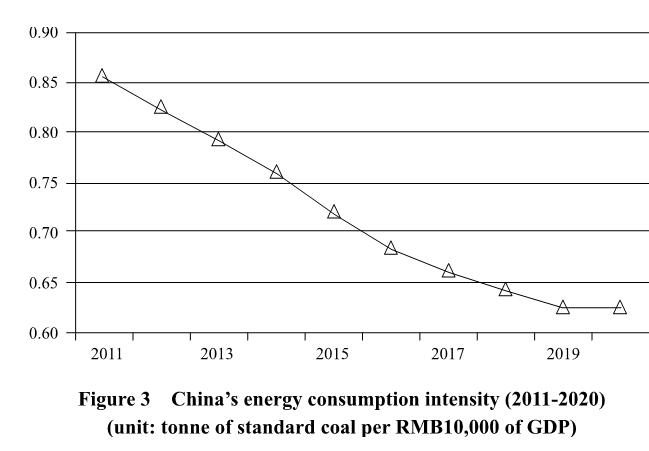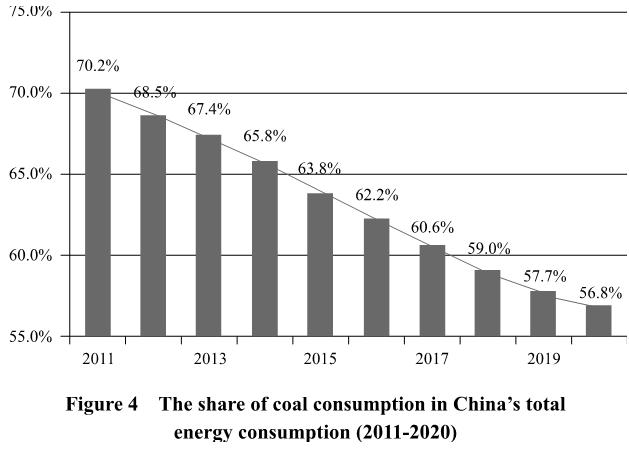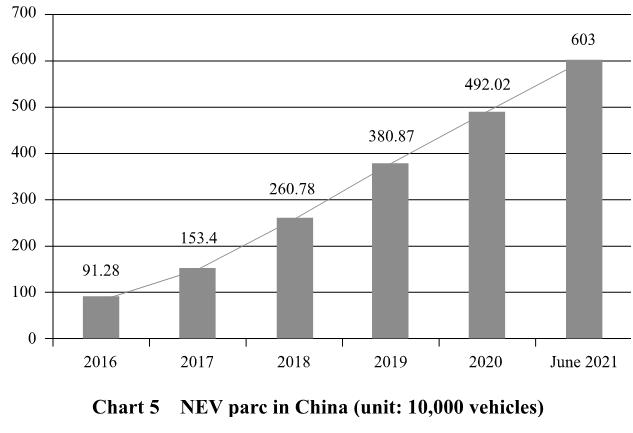


III. Significant Changes in China’s Response to Climate Change
China upholds the vision of innovative, coordinated, green, open and shared development. Based on domestic realities and taking into consideration the international situation, China continues to employ its wisdom and apply its solutions to the transition to green and low-carbon social and economic development. As a responsible major country, it is making its due contribution to the global response to climate change.
1. Coordinating Economic Development with Reductions in Pollution and Carbon Emissions
China follows the path of green, low-carbon and sustainable development, and is committed to integrating green development into the whole process of economic development. Greenness has become an integral component of sustained and high-quality social and economic development, and China's carbon intensity has decreased significantly.
China's carbon intensity in 2020 was 18.8 percent lower than that in 2015, a better result than the binding target set in the 13th Five-year Plan (2016-2020). The figure was also 48.4 percent less than that in 2005, which means that China had more than fulfilled its commitment to the international community – to achieve a 40-45 percent reduction in carbon intensity from the 2005 level by 2020. The drop in carbon intensity translates to a total reduction of about 5.8 billion tonnes of carbon dioxide emissions from 2005 to 2020, and demonstrates that China has largely reversed the rapid growth of its carbon dioxide emissions.
At the same time, China's economy has achieved leapfrog development. Its GDP in 2020 was more than four times greater than in 2005. It has achieved a great victory in moving nearly 100 million rural poor out of poverty, and succeeded in the arduous task of eliminating absolute poverty.

China has also achieved remarkable successes in eco-environmental protection, and the overall environment is becoming more beautiful. It has taken solid steps to build a beautiful China. The binding eco-environmental targets set in the 13th Five-year Plan have all been exceeded. The following results were achieved in 2020:
• The ratio of days with "excellent" air quality in cities at and above prefecture level was 87 percent (against a target of 84.5 percent).
• The average concentration of PM2.5 in cities at and above prefecture level went down by 28.8 percent from the 2015 level (against a target of 18 percent).
• The combined proportion of state-controlled water sections with good-quality surface water increased to 83.4 percent (against a target of 70 percent).
• The proportion of water sections with bad quality surface water below Grade V decreased to 0.6 percent (against a target of 5 percent).
Sulfur dioxide, nitrogen oxides, chemical oxygen demand, ammonia nitrogen emissions and carbon dioxide emissions per unit of GDP have continued to decline after China completed the 13th Five-year Plan ahead of schedule in 2019. The phased objectives and tasks of pollution prevention and control have been completed to a high standard. The battles to defend blue skies, clear waters and clean land and the seven landmark campaigns for pollution prevention and control have achieved decisive results. The number of days with heavy pollution has decreased significantly.
2. Remarkable Results in Revolutionizing Energy Production and Consumption
China has committed to implementing a new energy security strategy, with major changes made in energy production and utilization, and historic achievements in energy development. These provide vital momentum to achieve high-quality development, win the battle against poverty, and build a moderately prosperous society in all respects. They also contribute to China's drive to mitigate climate change and build a clean and beautiful world.

Non-fossil energy is developing rapidly. China gives priority to the development of non-fossil energy. It is vigorously developing and utilizing alternative energy sources, and promoting a green and low-carbon transformation of its energy industry. Preliminary calculations show that in 2020, non-fossil energy contributed 15.9 percent to China's total energy consumption, a significant increase of 8.5 percentage points compared with 2005. The total installed capacity of non-fossil energy power generation in China reached 980 million kW, accounting for 44.7 percent of total installed capacity. Within this figure, wind represented 280 million kW, PV 250 million kW, hydro 370 million kW, biomass 29.52 million kW, and nuclear power 49.89 million kW. PV power increased by a factor of more than 3,000 compared with 2005, and wind by a factor of more than 200. Electricity generated by non-fossil energy reached 2.6 trillion kWh, representing more than one third of the power consumption of the country.
China is rapidly reducing its energy consumption intensity. Preliminary calculations show that the reduction from 2011 to 2020 reached 28.7 percent, one of the fastest in the world. During the 13th Five-year Plan period (2016-2020), China fueled an average annual economic growth of 5.7 percent with an average annual energy consumption growth of 2.8 percent, and the amount of energy it saved accounted for about half of the global energy savings in the same period. China has been ranked among leading countries in the efficiency of coal consumption in its coal-fired power generation units. By the end of 2020, it had approximately 950 million kW of installed capacity in ultra-low emission units, and over 800 million kW of installed capacity in units that had undergone energy-saving transformation. The average coal consumption of thermal power plants had decreased to 305.8 grams of standard coal per kWh, down more than 27 grams compared with 2010. The energy saved represents a reduction of 370 million tonnes of carbon dioxide emission by coal-fired power generation units in 2020 compared with 2010.
From 2016 to 2020, China issued 16 mandatory energy consumption quota standards, achieving an annual energy saving of 77 million tonnes of standard coal, equivalent to 148 million tonnes of carbon dioxide emissions; it issued 26 mandatory product and equipment energy efficiency standards, realizing an annual power saving of 49 billion kWh.


China has accelerated the transformation to a clean and low-carbon energy consumption structure. In order to address pollution and climate change caused by fossil fuel combustion, China has strictly controlled coal consumption, and the proportion of coal consumption has continued to decline significantly. In 2020, China's total energy consumption was kept under 5 billion tonnes of standard coal. The proportion of coal in its total energy consumption dropped from 72.4 percent in 2005 to 56.8 percent in 2020. China exceeded the target for reducing coal production capacity and eliminated more than 45 million kW of outdated coal and electricity production capacity during the 2016-2020 period. By the end of 2020, the clean heating rate in winter in northern China had increased to more than 60 percent. Coal for non-industrial sectors has been replaced with cleaner energy in the power supply to around 25 million households in Beijing, Tianjin, Hebei and surrounding areas and on the Fenwei Plain, representing a reduction of around 50 million tonnes of coal for non-industrial sectors, which is equivalent to cutting about 92 million tonnes of carbon dioxide emissions.
Energy development significantly contributes to poverty alleviation. China has implemented a project to alleviate poverty through the rational development and utilization of energy resources in poor areas, effectively boosting their economic development capacity. China has built a total of more than 26 million kW of PV poverty-alleviation power stations, and thousands of “sunshine banks” in poor rural areas, benefiting about 60,000 poor villages and 4.15 million poor households. This innovative model for the integrated development of PV energy and agriculture is helping to win the battle against poverty.
3. Low-Carbon Industrial Transition Fueling Green Development
China has incorporated the concepts of putting the environment first and pursuing green development into its industrial upgrading. Through green, low carbon transformation of industries and the application of green, low carbon solutions, it has opened a new path to progress in both industrial development and environmental protection.
China is improving its industrial structure. Responding to climate change is a new mission for Chinese industry in its pursuit of green, low-carbon development, which also opens up new opportunities. The added value of tertiary industry made up 54.5 percent of China's GDP in 2020, 3.7 percentage points above that of 2015 and 16.7 percentage points higher than the figure for secondary industry. Strategic emerging industries such as energy conservation and environmental protection are growing rapidly and becoming pillars of the economy. Hi-tech manufacturing now accounts for 15.1 percent of the added value of industrial firms of designated size – with a revenue of RMB20 million and above per annum.
During the 2016-2020 period, China effectively reined in the expansion of energy-intensive industries, and accelerated the upgrading and transformation of key industries, including petrochemicals, chemicals, and iron & steel. Having set the goal of reducing the overcapacity of iron & steel production by up to 150 million tonnes during this period, it met the goal two years ahead of schedule, and decommissioned facilities producing substandard steel products to a total volume exceeding 100 million tonnes. It is estimated that from 2015 to 2020 carbon dioxide emissions per unit of added value of Chinese industries fell by about 22 percent.
In 2020, major resource productivity rose by approximately 26 percent from the 2015 level. About 260 million tonnes of scrap steel and 54.9 million tonnes of waste paper were reused, and the output of recycled non-ferrous metals reached 14.5 million tonnes.
The new energy industry is witnessing strong growth. The latest revolution in science and technology and industrial transformation has accelerated the growth of the NEV industry. China has topped the world in NEV output and sales for the last six years. In June 2021 the country's NEV fleet reached 6.03 million.

In the manufacture of wind power and PV power generation equipment, China has established the most complete industrial chain in the world, and is the global leader in terms of technology and output. The steady maturing of China's industrial chain for new energy storage and the diversity of its technology lend strength to the clean, low-carbon transition of the global energy sector. As of the end of 2020, China had secured the largest share in the global output of polycrystalline silicon, PV cells, and PV modules, and led the world in PV capacity additions for eight consecutive years; it had exported PV products to more than 200 countries and regions worldwide, helping to bring down the cost of clean energy globally; its installed capacity for new energy storage stood at 3.3 million kW, the largest in the world.
Green, energy-efficient buildings are growing rapidly. Under its green development philosophy, China has made sweeping efforts to promote eco-friendly and energy-efficient buildings, in a bid to harness the full potential for carbon emissions reduction in the architectural sector. By the end of 2020 the floorage of China's green buildings had exceeded 6.6 billion square meters, with as many as 77 percent of urban buildings completed in the year meeting the green standard. The floorage of energy-efficient buildings had surpassed 23.8 billion square meters, accounting for more than 63 percent of the total floor space of urban civic buildings.
During the 2016-2020 period China further raised its energy conservation standard for newly built urban buildings. It improved energy efficiency over 514 million square meters of floor space in existing civic buildings and 185 million square meters in public buildings, and increased the share of renewable energy in energy use by civic buildings to six percent.
Steady progress is being made in green transport. China is firmly committed to energy conservation and emissions reduction in the transport industry. It has therefore devised a means of reducing energy consumption and carbon emissions while maintaining economic growth. With steady improvements to the integrated transport system, more bulk cargos are carried by train and ship instead of truck, and river-sea shipping and multimodal transport continue to expand. By 2020 the share of railways in China's total freight volume had increased by nearly two percentage points over 2017, and the volume of river and sea freight had grown by 3.83 billion tonnes compared to 2010. Between 2016 and 2020 the volume of intermodal rail-water freight grew by an average of 23 percent year on year.
Notable progress has also been made in building low-carbon urban transport systems. As of the end of 2020, 87 cities on China's mainland had joined the national program to improve public transport, and 43 cities had launched urban rail transit networks. During the 2016-2020 period, trips by urban public transport exceeded 427 billion, signifying a steady increase in the proportion of city dwellers using public transport.
4. Marked Increase in the Carbon Sink Capacity of Ecosystems
China has taken various measures to build up the carbon sink capacity of ecosystems and ensure that forests, grasslands, wetlands, oceans, soil and frigid zones play their role in carbon sequestration. With the highest growth in forest coverage and the largest area of man-made forests, China leads the world in greening the planet. In the decade between 2010 and 2020, 7.2 million ha of marginal farmland were turned into forest and grassland. By 2020, vegetation coverage of its grasslands was 56.1 percent, and more than half of its wetland areas were under protection.
In the 2016-2020 period, 36.3 million ha of forests were planted, and 42.5 million ha of forests were tended. At the end of 2020, China's forest area stood at 220 million ha, its forest coverage reached 23 percent, and forest carbon storage approached 9.19 billion tonnes. Forests, the lungs of the earth, are playing their due role as an important carbon sink.
During the five years from 2016 to 2020, China conducted desertification control on almost 11 million ha, addressed stony desertification on 1.65 million ha, and applied comprehensive treatment of soil erosion to an additional 310,000 square kilometers of land. Saihanba and Kubuqi are two shining examples of this “desert to oasis” miracle China has created. China also restored 467,400 ha of degraded wetlands, and added 202,600 ha of new wetlands.
By the end of 2020 China had established 474 national nature reserves, which accounted for more than one tenth of its land mass. It had cultivated 53.3 million ha of high-quality farmland, and restored 1,200 km of coastline and 23,000 ha of coastal wetlands. As a result, ecosystems are better conserved and geared to play their role as carbon sinks.
5. Green and Low Carbon Lifestyles Gaining Popularity
Green living is a prerequisite for building a beautiful China, and every member of society has become conscious of the need and is ready to act. Through regular activities, including those for National Energy Conservation Week, National Low Carbon Day and World Environment Day, China educates the public about climate change. It also promotes the concept of eco-civilization, including climate change and green development, in the national education system, and organizes training courses for the public on responding to climate change.
The "Beautiful China, I'm a Contributor" campaign is sweeping the nation, attracting large numbers of participants. Urban public vehicles, mainly buses and subways, carry over 200 million passengers every day, roads and facilities friendly to cycling and walking are expanding in urban areas, and more people are favoring green, low-carbon modes of transport.
In addition, tens of thousands of households are practicing thrift through actions such as saving food, water, paper, and energy, choosing eco-friendly materials for home decoration, and saying no to over-packaging and disposable products. The nation is turning towards a thrifty, healthy, green and low-carbon lifestyle.
